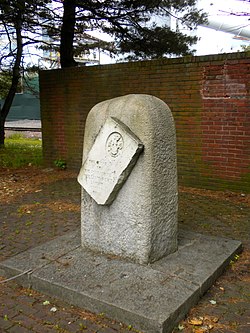William Penn Landing Site
|
William Penn Landing Site
|
|

William Penn Landing Site Monument, May 2010
|
|
| Location | Penn and Front Sts., Chester, Pennsylvania |
|---|---|
| Coordinates | 39°50′36″N 75°21′41″W / 39.84333°N 75.36139°WCoordinates: 39°50′36″N 75°21′41″W / 39.84333°N 75.36139°W |
| Area | less than one acre |
| Built | 1882 |
| Architect | Struthers, John |
| NRHP Reference # | 71000703 |
| Significant dates | |
| Added to NRHP | March 11, 1971 |
| Designated PHMC | October 13, 1947 |
The monument at the William Penn Landing Site marks the spot of the first landing of William Penn on the territory of Pennsylvania, on October 28 or 29, 1682 (O.S.). Penn, the founder of the Province of Pennsylvania, landed in the only town in the province, then known as Upland, but since known as Chester.
The monument at the site was designed by John Struthers, erected on November 8 and dedicated November 9, 1882 (N.S.) The landing site was placed on the National Register of Historic Places in 1971.
After receiving the charter for the Province of Pennsylvania on March 4, 1681 from King Charles II of England, Penn appointed William Markham as Deputy Governor on April 10, 1681. Markham proceeded to New York, which had exercised nominal control of the area of Pennsylvania since 1676, where he presented his credentials. On August 3, 1681, Markham arrived in Upland, the only town in the province. About 500 Europeans lived in the province at that time, mostly in the present day counties of Delaware and Chester centered around Upland. Swedish and Dutch settlers had lived in the area since the 1630s, and Quakers had moved there from West Jersey starting about 1675. What little government there was, had been provided by the Upland Court under the laws of James, Duke of York, nominally supervised by the Governor of New York. The Upland Court exercised judicial, legislative, and executive authority.
Markham appointed judges to the court and members to a council. He also met with Charles Calvert, 3rd Baron Baltimore in Upland, who informed him that the Pennsylvania-Maryland border was about 12 miles north. Markham apparently informed Penn of the border dispute. Penn then arranged to receive deeds from the Duke of York to the "three lower counties" which now comprise the state of Delaware, thus strengthening his claims further north on the Delaware River.
...
Wikipedia


